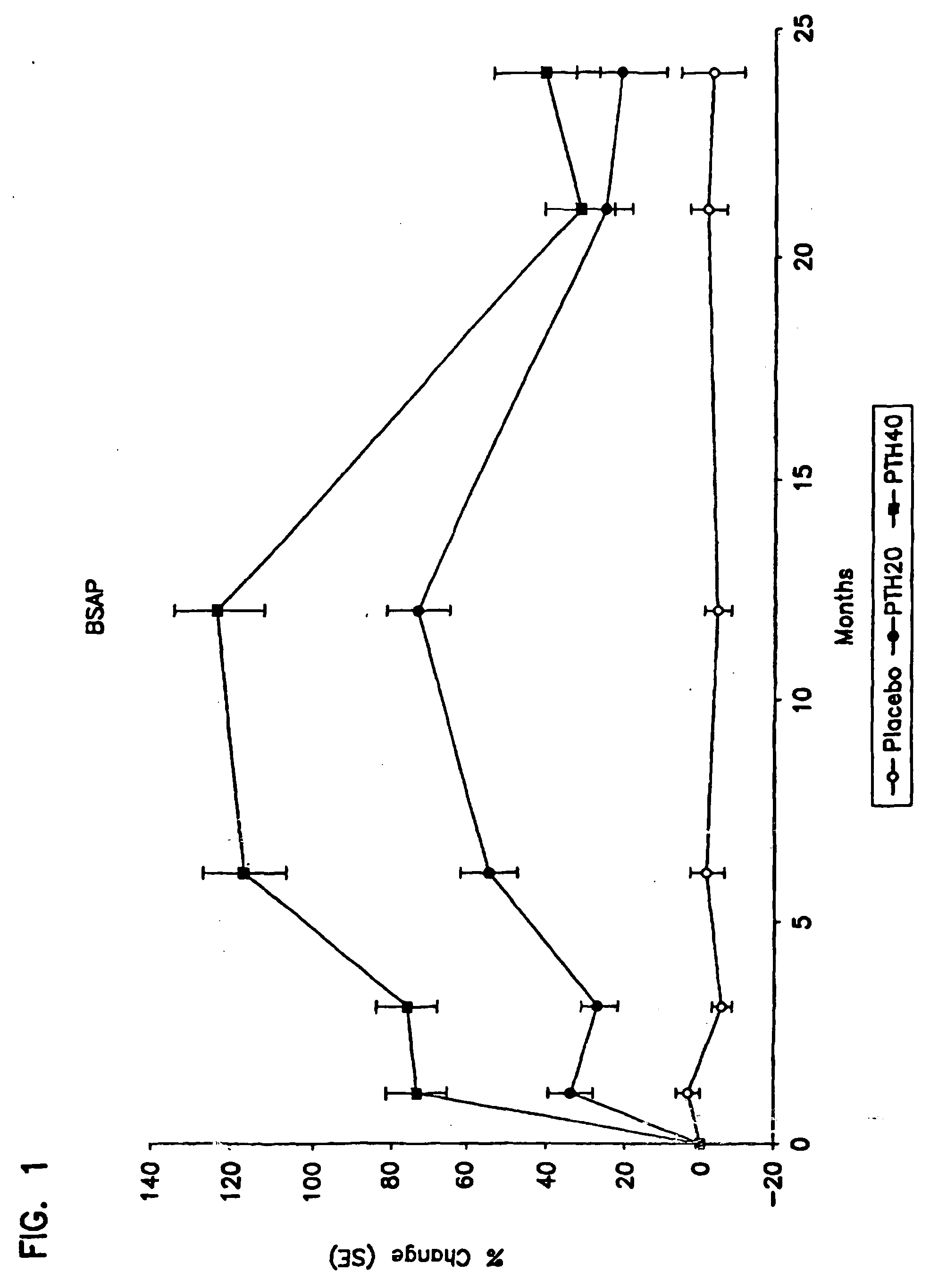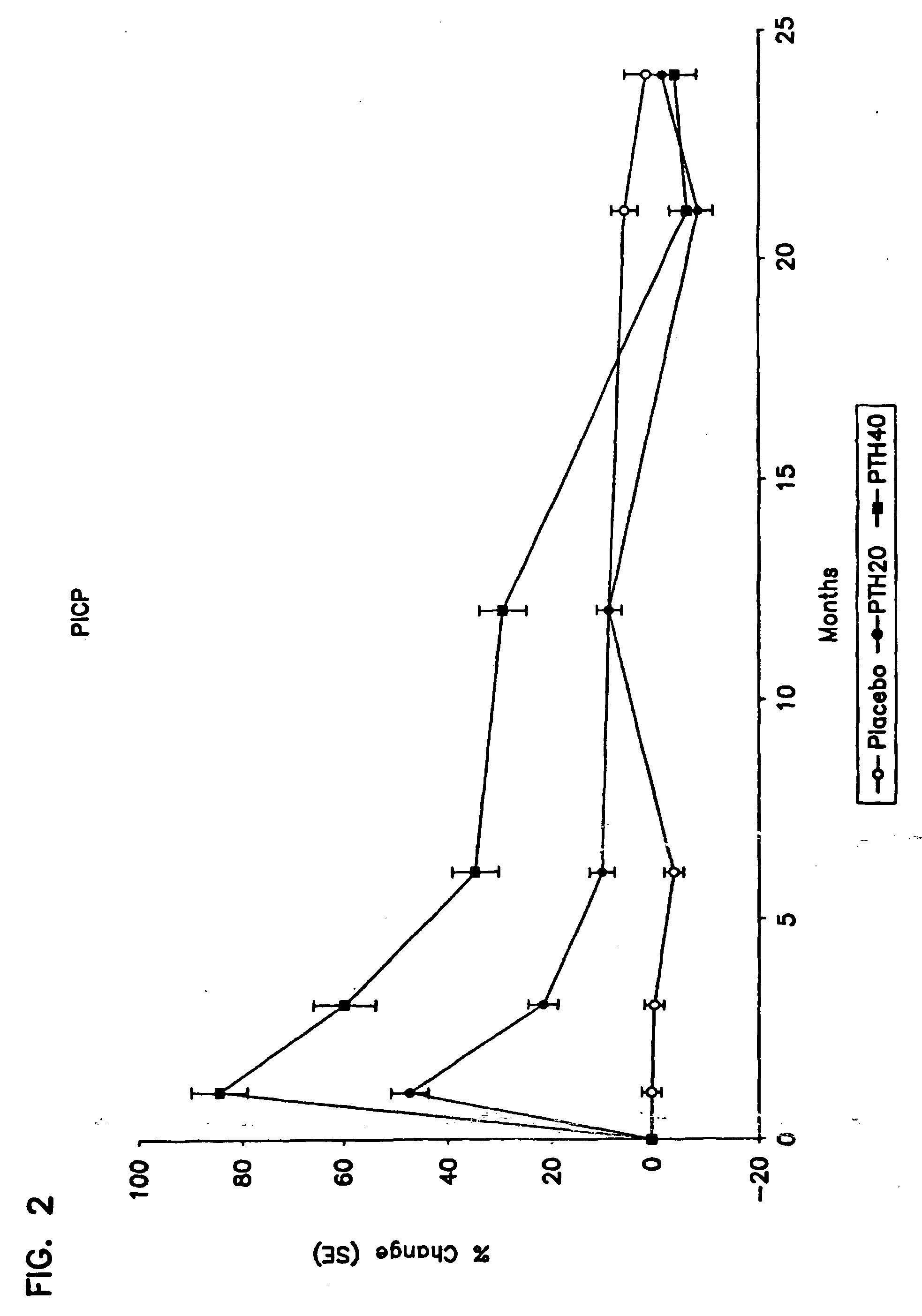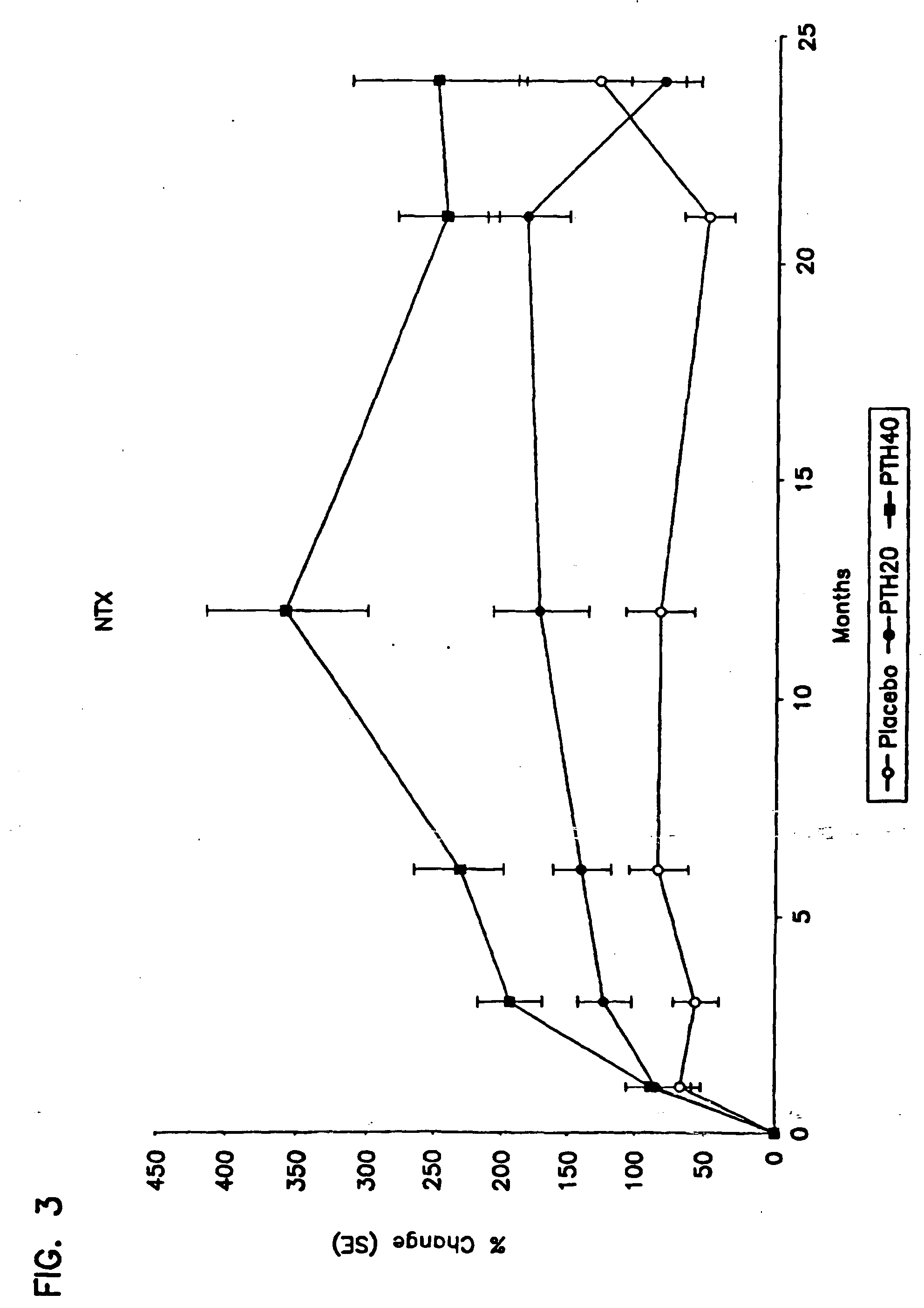Method for monitoring treatment with a parathyroid hormone
a parathyroid hormone and treatment technology, applied in the field of monitoring treatment with a parathyroid hormone, can solve the problems of not treating or preventing several other indications of osteoporosis, reducing the incidence of fractures. , to achieve the effect of reducing the incidence of diabetes, increasing bone toughness and stiffness, and reducing the incidence of fractures
- Summary
- Abstract
- Description
- Claims
- Application Information
AI Technical Summary
Benefits of technology
Problems solved by technology
Method used
Image
Examples
example 1
Monitoring Administration of rhPTH(1-34) to Humans by Monitoring Markers of Bone Formation and / or Resorption
[0099] Number of Subjects: [0100] rhPTH(1-34): 1093 enrolled, 848 finished. [0101] Placebo: 544 enrolled, 447 finished. [0102] Diagnosis and Inclusion Criteria: Women ages 30 to 85 years, postmenopausal for a minimum of 5 years, with a minimum of one moderate or two mild atraumatic vertebral fractures. [0103] Dosage and Administration: [0104] Test Product (blinded) [0105] rhPTH(1-34): 20 μg / day, given subcutaneously [0106] rhPTH(1-34): 40 μg / day, given subcutaneously [0107] Reference Therapy (blinded) [0108] Placebo study material for injection [0109] Duration of Treatment: [0110] rhPTH(1-34): 17-23 months (excluding 6-month run-in phase) [0111] Placebo: 17-23 months (excluding 6-month run-in phase) [0112] Criteria for Evaluation: Spine x-ray; serum biological markers (calcium, bone-specific alkaline phosphatase, procollagen I carboxy-terminal propeptide); urine markers (calc...
example 2
Monitoring Administration of rhPTH(1-34) to Humans also Receiving Hormone Replacement Therapy by Monitoring Markers of Bone Formation and / or Resorption
[0121] Number of Subjects: [0122] rhPTH(1-34) plus hormone replacement therapy (HRT) (estrogen±progesterone): 122 enrolled, 91 finished. [0123] Control, hormone replacement therapy (estrogen±progesterone) without PTH: 125 enrolled, 105 finished. [0124] Diagnosis and Inclusion Criteria: Women aged 62±8 years, postmenopausal for 15±8 years, selected for a baseline spine bone mineral density of 0.9±0.15 and a T value of −1.8. [0125] Dosage and Administration: [0126] Test Product (blinded) [0127] rhPTH(1-34): 40 μg / day, given subcutaneously plus hormone replacement therapy (estrogen±progesterone). Subjects continued their prestudy hormone replacement therapy, maintained an HRT regimen consistent with local medical practices, took continuous / combined estrogen and progestin therapy using oral Premarin (0.625 mg / day) and oral Provera (2.5 m...
example 3
Monitoring Administration of rhPTH(1-34) to Humans by Monitoring Markers of Bone Formation and / or Resorption and Comparison to Treatment with an Antiresorptive
[0143] Number of Subjects: [0144] rhPTH(1-34): 73 enrolled, 51 finished. [0145] Alendronate (Fosamax®): 73 enrolled, 57 finished. [0146] Diagnosis and Inclusion Criteria: Women aged 65±8 years, postmenopausal for 19±19 years, selected for a baseline spine bone mineral density of 0.8±0.1 and a T value of −2.2.
Dosage and Administration: [0147] Test Product (blinded) [0148] rhPTH(1-34): 40 μg / day, given subcutaneously [0149] Reference (Control) Therapy (blinded) [0150] Alendronate (Fosamax®): 10 mg per patient per day [0151] Duration of Treatment: [0152] rhPTH(1-34): 12-18 months, with follow up from time of withdrawal of drug to 18 months of study. [0153] Alendronate: 12-18 months, with follow up from time of withdrawal of drug to 18 months of study. [0154] Criteria for Evaluation: Spine x-ray, serum biological markers (calci...
PUM
| Property | Measurement | Unit |
|---|---|---|
| time | aaaaa | aaaaa |
| time | aaaaa | aaaaa |
| time | aaaaa | aaaaa |
Abstract
Description
Claims
Application Information
 Login to View More
Login to View More - R&D
- Intellectual Property
- Life Sciences
- Materials
- Tech Scout
- Unparalleled Data Quality
- Higher Quality Content
- 60% Fewer Hallucinations
Browse by: Latest US Patents, China's latest patents, Technical Efficacy Thesaurus, Application Domain, Technology Topic, Popular Technical Reports.
© 2025 PatSnap. All rights reserved.Legal|Privacy policy|Modern Slavery Act Transparency Statement|Sitemap|About US| Contact US: help@patsnap.com



